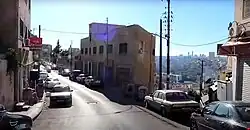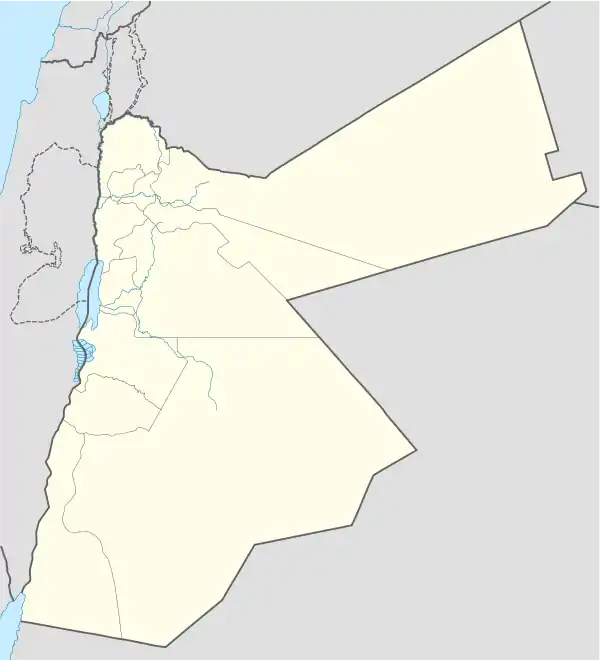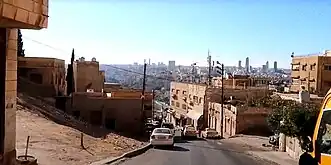Jabal al-Ashrafiyah
جبل الأشرفية Ashrafiyah | |
|---|---|
Hill and settlement | |
 al-Hattai Street with Amman's skyline in background | |
 Jabal al-Ashrafiyah Location within Jordan | |
| Coordinates: 31°56′36″N 35°56′05″E / 31.943441°N 35.934757°E | |
| Country | |
| Governorate | Capital Governorate |
| Municipality | Greater Amman Municipality |
| City | Amman |
| Established | Ammonite kingdom BCE |
| Elevation | 850 m (2,790 ft) |
| Population (2009) | 8,200 |
| Time zone | UTC + 2 |
Jabal al-Ashrafieh (Arabic: جبل الأشرفية, often called al-Ashrafiyah or simply Ashrafiya) is a town and neighbourhood in Amman, Jordan. Located in East Amman, it is the highest point in the city and it features many services, such as schools, restaurants, and shopfronts.[1] The town is renowned for its mosques and churches, in addition to being encircled by many historical buildings.[2] Other spelling variants and forms of the town's name include, Ashrafia, Ashrafieh, Jabal al-Ashrafiyah, Jebel Ashrafiya and Jebel El Ashrafiya.
Topography

Jabal al-Ashrafieh is a hill station that is divided into several areas, the most important of which are the Ashrafieh circuit and the Armenian neighborhood named Hay Al-Arman (حي الأرمن). A large shopping square is present. It is also close to the Al-Wahdat area and has Barto Street, which panoramically overlooks the city center, Al-Masdar, and the ancient Roman amphitheater, due to its high elevation. In Arabic, "ashrafiya" means 'honorable one' and "jabal" translates to 'mountain', as the area is very hilly with precipitous, serpentine streets and steep staircases that wind through the area, some of which that lead to downtown Amman.[3]
Facilities and health
In 2020, the Harra rejuvenation strategy, based on the physical, environmental, educational and social aspects of the community, has successfully revitalized area in a span of 12 years.[4] Established in 2008, a Community Development Center exists in the town, which specializes in community mobilization, law issues and reducing inequality in the area.[5][6] The Jordan National Red Crescent Society is headquartered in the town.[7]
The town features two prominent hospitals, Al-Bashir Hospital and the Italian Hospital. Medical research has occurred in Al-Bashir Hospital.[8]
Religion and culture
After the 1948 Palestinian expulsion and flight, many Palestinian people settled in Ashrafiya, living in tents across the city.[9] Today, the neighbourhood contains a number of churches, including an Assyrian Church, an Armenian Church (Saint Thaddeus Armenian Apostolic Church), an Armenian Catholic Church, and St Paul's Church, which is an Anglican church that is under the responsibility of an Iraqi Muslim that redistributes medicine, in addition to teaching English and music to children and adults alike.[10]
There is also the Abu Darwish Mosque, a branch of the Amman Municipality built in 1961, which is notable for its checkered black-and-white pattern, and having an architectural style that is unique to Jordan.[11]

Armenian community
The Armenian community in al-Ashrafiya is the second largest Christian community of Jordan. In 2019, there were around 5,000 Armenians in the area, most of whom are descendants of those who fled the Ottoman Empire during the 1915 Armenian Genocide.[12] The next wave of Armenian refugees settled in Jordan after the First Arab-Israeli War in 1948, where there were around 10,000 Armenian inhabitants in the area. In 1962, the first Armenian church (St Thaddeus Church) and school were established.[3]
From the 1970s and onwards, the Armenians in the area gradually began to immigrate to the United States, Canada and Australia. Armenians living in the area today still preserve their culture; they have an Armenian elementary school, a kindergarten and Armenian pizzerias.[12]
Palestinian–Jordanian conflict
In September 1970, Jordan permitted Palestinian military forces to operate independently in Amman. But the Palestinians' disappointment at not being able to claim the West Bank turned against Jordan. Thereafter, the Palestinians in Jordan battled Jordanian soldiers in a brief, but intense civil war.[9] The conflict between Palestinians and Jordanians was so pernicious that Jordanian army officers had to change into civilian apparel in order to enter Ashrafiyah to avoid being assaulted in the predominantly Palestinian neighborhood.[13]
Population
In 2009, al-Ashrafia had a population of 8,200.[5] In 2010, the population density of the town, combined with the surrounding neighbourhoods, was over 20,000 inhabitants per square kilometre.[14]
Gallery
 Residential area on Hatim al-Tai Stairs (from Al-Kuwait Street)
Residential area on Hatim al-Tai Stairs (from Al-Kuwait Street) Amman skyline viewed from Hatem al-Tai Street
Amman skyline viewed from Hatem al-Tai Street Corner shops at Hatem al-Tai Street
Corner shops at Hatem al-Tai Street A hilly neighborhood zone on the Hatem al-Tai Stairs
A hilly neighborhood zone on the Hatem al-Tai Stairs Apartments at Hatem Al-Tai Street
Apartments at Hatem Al-Tai Street A stairway within the town
A stairway within the town Abu Darwish Mosque
Abu Darwish Mosque The craggy topography with the mosque in view
The craggy topography with the mosque in view
See also
References
- ↑ Held, Colbert C; Cummings, John Thomas (4 May 2018). Middle East Patterns: Places, People, and Politics. Routledge, 2018. p. 350. ISBN 9780429962004.
- ↑ "Canvas Wall Painting - Al Ashrafiya Stairs". Souq Fann logo. Retrieved 12 November 2023.
- 1 2 "An Ode to Amman". 7iber. Retrieved 12 November 2023.
- ↑ "A Jordanian NGO takes on social ills in Amman neighborhoods". Arab News. Retrieved 12 November 2023.
- 1 2 Mary-Katharine Johnson (8 May 2010). "Civil Society and Inequality in Jordan: A Study on the Effectiveness of the Community Development Center in Ashrafiyah". Independent Study Project (ISP). Retrieved 12 November 2023.
- ↑ Johnson, M.K., 2010. “Civil Society and Inequality in Jordan: A Study on the Effectiveness of the Community Development Center in Ashrafiyah.” Independent Study Project (ISP) Collection. Paper 831.
- ↑ "Red Crescent Society now accepting applications for vocational training programme". The Jordan Times. Retrieved 12 November 2023.
- ↑ "A Case Report of Two Primary Cancers, Breast Cancer with Adrenal Gland Metastatic and Second Primary Neuroendocrine Tumor in Colon, a Rare Case in Al-Bashir Hospital". Department of Clinical Oncology and Radiation Therapy, Al-Bashir Hospital, Al-Ashrafiyah, Amman, Jordan Inc. Retrieved 12 November 2023.
- 1 2 "The Palestinians of Jebel Ashrafiya". Catholic Near East Welfare Association. Retrieved 12 November 2023.
- ↑ "Archbishop Explores Parish Ministry in Amman as Jordan Visit Concludes". United Dioceses of Dublin & Glendalough. Retrieved 12 November 2023.
- ↑ "Amman – a modern city built on the sands of time". Jordan Travel. jordantoursandtravel.com. Archived from the original on 4 March 2016. Retrieved 22 September 2015.
- 1 2 "Aleksander Lapshin shares story about "Little Armenia in Jordan"". news.am. Retrieved 14 November 2023.
- ↑ "AMMAN 1970, A MEMOIR" (PDF). Middle East Review of International Affairs, Vol. 6, No. 4. Retrieved 12 November 2023.
- ↑ Myriam Ababsa. "Social Disparities and Public Policies in Amman". Disparités sociales et politiques publiques à Amman. Retrieved 12 November 2023.